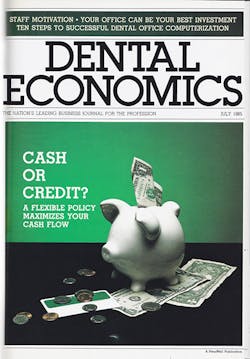by Paul Zuelke
Here are the opening words of the cover article I wrote for this magazine in the July 1985 issue:
"Many dentists perceive a dilemma in making a decision concerning operating a cash practice (no financing offered except via third party finance companies) or a credit practice (offering patients payment plans on diagnosed treatment). The dilemma they see is this: Productivity and gross production slows down when you require payment at the time of service, but the collection percentage declines and delinquency increases when you grant credit. What is the solution?"
Today, 29 years later, dentists ask themselves the very same question and have the exact same fears and concerns. You know that a practice with a "cash-only" policy collects 100% of what it produces, has little delinquency, and maintains very low accounts receivable, but you also know that such a practice most often has many tens of thousands of dollars of diagnosed but unscheduled production.
A "cash-only" practice's schedule is often unproductive because of missed appointments due to patients' lack of funds. Marketing for new patients is always a battle for a cash-only practice, so much so that many practices start retail advertising in order to build new patient flow. You have also learned that a cash-only practice soon becomes heavily dependent on insured patients, so dependent, in fact, that many practices sign on with PPOs and other insurance "plans," most often resulting in heavy fee discounting and an unsatisfactory net.
While dentists know that being a cash-only practice has a real set of substantial problems, and while they also know that allowing liberal and flexible payment plans will improve case acceptance and production dramatically, experiments with credit granting have often been a disaster. Some of these experiments were purposeful - for friends and other "special" patients, for example. Some were accidental - due to an unscheduled crown prep or root canal on an emergency patient who could not pay, for example. If you are one of the dentists who have learned from these experiences, you have most likely realized that the true problem with patient delinquency goes far beyond whether or not you got paid. You have learned that delinquent patients are the ones who "no show," cancel, and reschedule appointments far more frequently than those patients who are not delinquent. Delinquent patients have more emergencies. Delinquent patients are rude, discourteous, and demanding more frequently than others. Delinquent patients file the great majority of malpractice lawsuits and, most importantly, delinquent patients never refer their friends and family to you. Simply put, being a cash-only practice is believed to be the lesser of two evils!
That 1985 Dental Economics article described a third choice, a hybrid of the first two, that over these past 29 years thousands of doctors have used to build healthy and productive practices. These doctors have the best of both worlds ... high case acceptance and production, a perfect collection rate, insignificant delinquency, an efficient schedule, and high rates of patient referrals. This third option is to be a credit granting practice, but to grant credit exactly like every other creditor in the world grants credit: That is, in proportion to the risk.
Since 1980, I've taught dentists how to identify the risk of any given patient (or responsible party). I've also taught these dentists how to establish financial policies and customize financial arrangements in order to obtain the best possible case acceptance while also ensuring that they will get paid in an appropriate manner. Until recently, utilizing this third option in a practice required the practice to have a well-trained financial coordinator who understood how to determine the maturity, stability, and integrity of each responsible party. Being able to make this determination included the ability to obtain and interpret credit bureau reports, and to review a patient history document that identified factors such as age, time at an address, time at a job, type of job, etc. Using this information, a well-trained financial coordinator can determine the amount of a down payment (if any) that was to be required and the length of payment plan that was to be allowed.
Over the years, my associates and I have taught practices this: Stable people with excellent credit could be trusted to keep their financial agreements and should be allowed, when necessary, low and even $0 down payments and fairly long-term payment plans. We also taught that high-risk patients should be identified early and required to submit to cash-only terms. Finally, we have taught that there are medium-risk patients whose financial arrangements are between these extremes. Again, the point is that credit should be granted in order to improve case acceptance and also to acknowledge the fact that dentistry is expensive and that not all patients have the financial means to pay in full for treatment. Credit should be granted in direct proportion to risk with the knowledge that some patients are risky, and only a policy requiring a large down payment or even payment-in-full for these high-risk patients is sufficient to eliminate that risk.
With the decline in the number of patients with dental insurance (traditional as well as PPO!) that has occurred during the most recent 12 months - and the forecasted 50% additional decline in the coming 3-5 years (due to the Affordable Care Act) - building a great patient-centric reputation is more important than it has ever been. Having a flexible financial policy that makes your treatment affordable is a huge part of building that reputation.
The great news is that technology has come a very long way and it is now quite easy and relatively inexpensive to identify the true credit-worthiness of your patients. The ZACC tool (getzacc.com) identifies, in less than a minute and with great accuracy, the maturity, stability, and credit-worthiness of any person. Plus, it does so without impacting a patient's credit score and without showing up as an inquiry on a person's credit report. It also provides a recommended minimum down payment and maximum payment plan length for each patient.
Take the time to identify the risk of each of your patients and grant credit proportional to that risk. The risk is small and the payoff in practice growth and quality of life within the practice is spectacular!
Paul Zuelke is president and founder of Zuelke & Associates, Inc., a management consulting firm specializing exclusively in teaching credit management and accounts receivable control techniques to dental and orthodontic practices.







